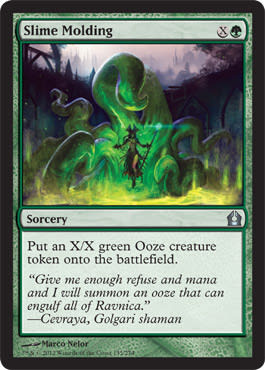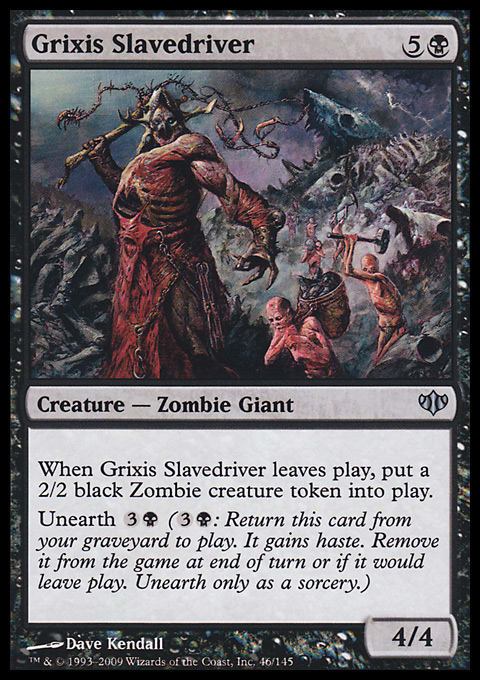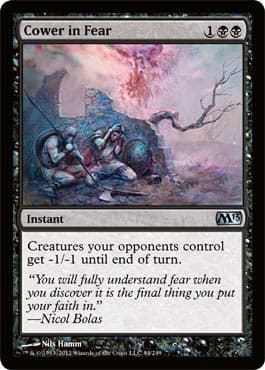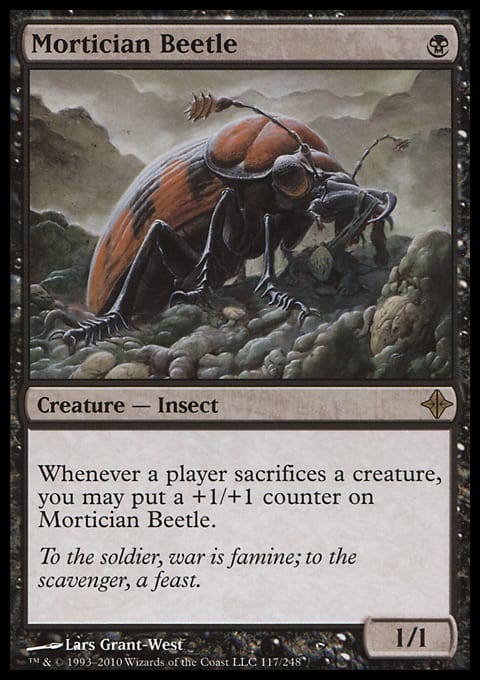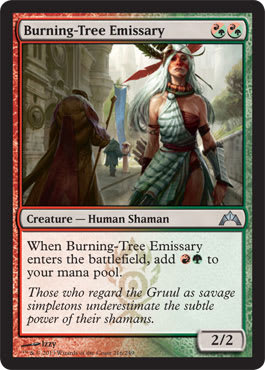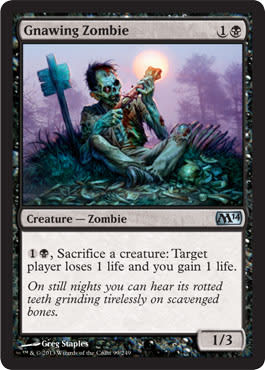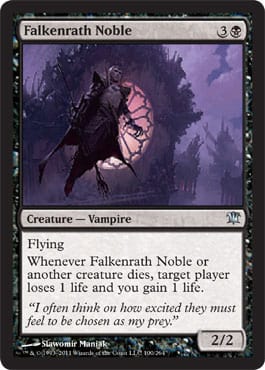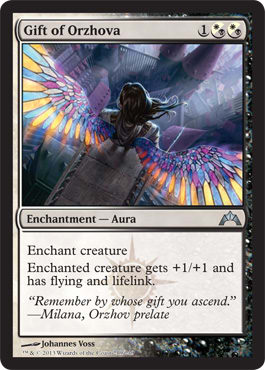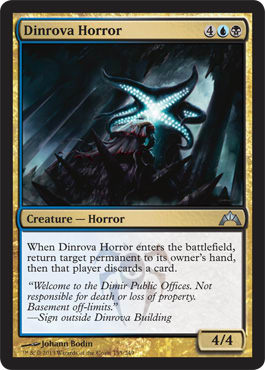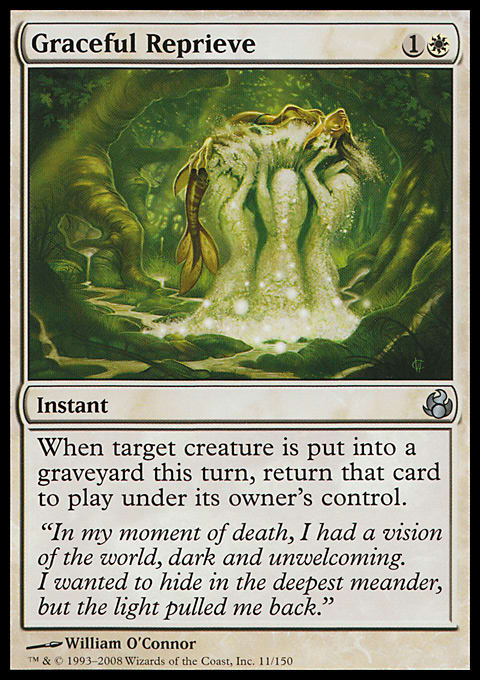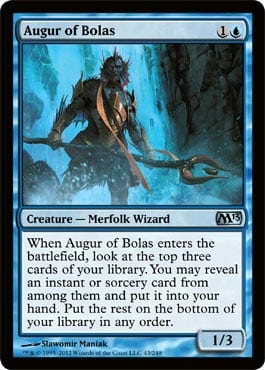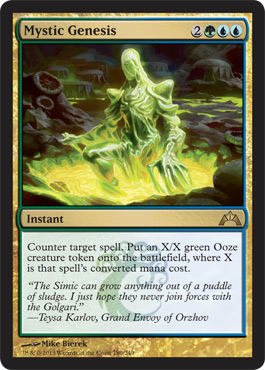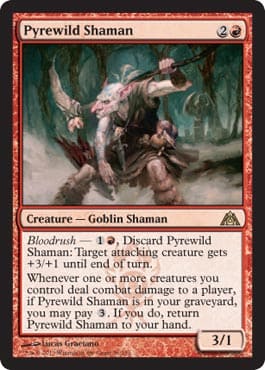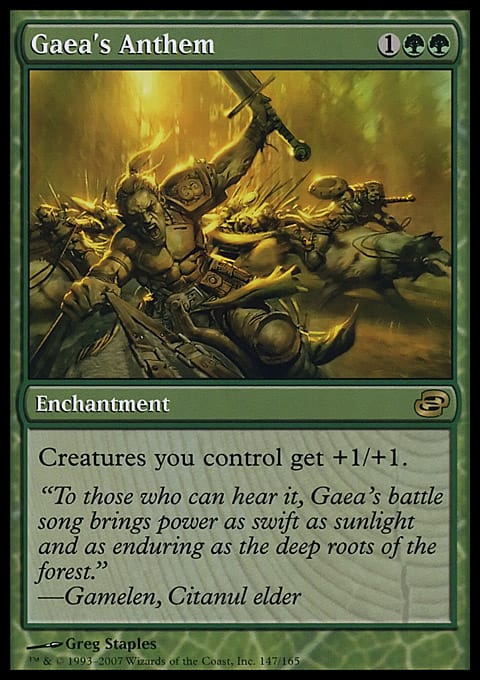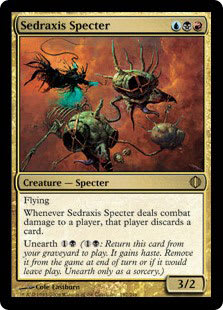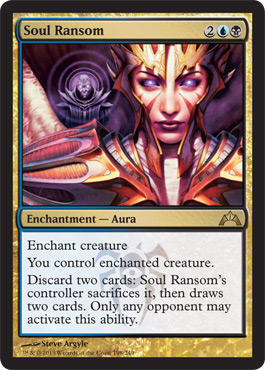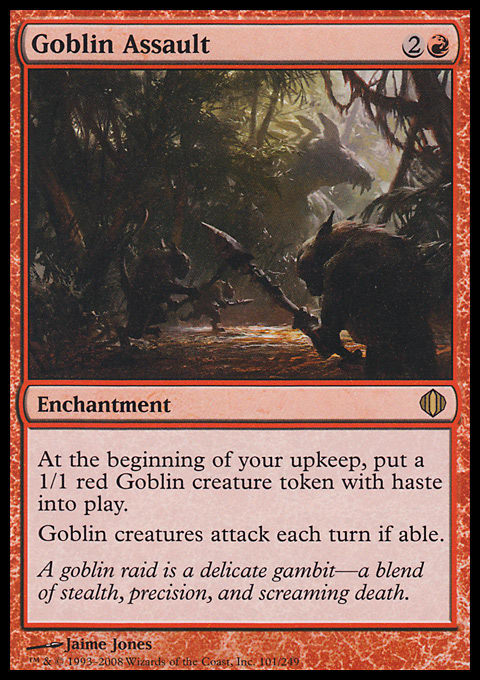Alex Ullman nailed the impact of Modern Masters 2017 in usual fashion , as well as covering its Magic Online impact; but, in this article, I want to talk about the format's impact for rarity-restricted Cubes: Peasant and Pauper Cubes. As opposed to the usual format where I discuss by keyword, I'll be breaking these down by rarity downshifts and archetype.
Full disclosure: I've had a Pauper Cube since late 2010 but I don't have a Peasant Cube. Therefore, I don't have a lot of experience with these cards in that format. That said, while I'm going to reference how some these cards played in Modern Masters 2017 to provide some background examples, the Pauper Cube evaluations are based on real-world Pauper Cube experience, not merely outsourcing to Modern Masters 2017 Limited.
Downshifted to Common
Slime Molding looked to be a solid addition to a color that really lacks late-game payoffs, as Green doesn't have a lot of high-mana cost creatures that demand an answer or can stabilize you. The format lacks cards like Primeval Titan and Hornet Queen. Unfortunately, I found that Slime Molding underperformed often.
While it's cliché to say X spells tend to be underrepresented in Cube since they aren't very good in any particular mode, but make up for it with flexibility, I found that Slime Molding's token lacking any kind of evasion or protection often made the token vulnerable and/or irrelevant. Even in times when an opponent didn't have spot removal to stop it, its lack of impact made it so that it could be played around and there was never really a casting cost where it felt good to cast. All in all, it was a relatively mediocre card.
Tandem Lookout fails the saboteur test since it lacks evasion, as the saboteurs without evasion that are good in Cubes need to be dirt cheap to get under potential blockers or be good enough by themselves for its saboteur ability to be gravy, not the main course.
Tandem Lookout worked well with Blue's evasive fliers and other colors' fliers (particularly White). It also works with other colors' above-rate creatures, like Elite Vanguard and Terrain Elemental, triggering immediately after you play and bond it. This makes Lookout a solid addition to Blue tempo decks and aggressive decks that splash for Blue.
Control decks don't tend to have as many creatures that are used solely for attacking (although the format tends to be more creature-based than Cubes that include rares) and pairing it up with a value creature like an Aethersnipe or an Archaeomancer can help to turn the corner. However, those decks aren't really in the market for that kind of card, since Tandem Lookout doesn't really do much until those decks have stabilized enough to turn the corner already.
Since Tandem Lookout triggers on any type of damage, there's some synergies with pingers like Vulshok Sorcerer (it's pretty absurd with Thermo-Alchemist) and, as is generally the case in any Cube, Blue can be very tight due to how good its cards are. However, Tandem Lookout has performed well enough for the decks that want it to be a strong inclusion.
Grixis Slavedriver represents a lot of value. On first look, it acts as a creature with a form of persist since it has a form removal insurance. As a six-mana 4/4 without evasion, it's arguable whether your opponent would even bother wasting removal on it, but in Pauper Cube a 4/4 tends to be on the large side — when I last counted the creatures in my Pauper Cube, only about 15 could survive a fight with a 4/4 (and most other Pauper Cube lists seem to show a similar amount) — so it’s usually respected on a board state, even if it's just getting chump blocked. Six mana is still six mana, though; and, as a creature with no immediate impact, this isn't something aggressive decks really want as a curve topper. It seems best sideboarded in matchups where the opponent kills everything on sight and having a big creature that leaves behind a 2/2 is a boon. However, we never ran it in aggro maindecks.
Grixis Slavedriver triggering when leaving play did provide some incentives in combinations like Orzhov, Dimir and Esper midrange and control. It combines well with blink effects like Ghostly Flicker and Otherworldly Journey, cards that take advantage of the “leaves the battlefield” trigger while preserving it’s ability to unearth if it eventually dies. I've found this strategy fit those decks incredibly well. Most unearth creatures in the format don't really provide a lot of value (aside from Dregscape Zombie in an aggressive deck) and were more on the axis of dumb beaters. So, it's nice to see something on the opposite end of the spectrum for slower decks. It's worked pretty well as a late-game payoff card, especially if the deck features a Ghostly Flicker type effect.
Cower in Fear: Pauper Cube tends to have a lack of mass removal, seeing as how little mass removal is printed at common nowadays. As Alex pointed out, its most similar analogue is to Electrickery, as something to pick off smaller creatures, while also acting as a combat trick. Most creatures in the format tend to be in the smaller range, from 1/1—2/2, so changing their power can help in board states when alpha striking. In practice, its impact was pretty small most of the time. It ended up being a tool Black decks used against lower-to-the-ground decks, rather than something they wanted for all matchups. So, pretty mediocre overall.
Mortician Beetle: Typically these rare to common downshifts tend to be mediocre in Pauper Cube, as Scion of the Wild and Emperor Crocodile (ignoring ones like Elvish Vanguard) usually ended up being anything but the format defining all-stars one would expect. The downshifts were carefully considered as backbones of Masters limited format archetypes and for the Pauper format. Similar to non-Standard formats like Vintage, cards are placed in those formats with consideration for how they'd play out in formats like Pauper, but they aren't specifically tested for those formats.
Black decks can utilize creatures like Nantuko Husk and its many iterations (and other cards like Bloodthrone Vampire and Carrion Feeder) to create a synergistic deck that focuses on recursion or making blocks awkward by threatening lethal damage with a couple of sacrifices. Instead of being a standalone card like Nantuko Husk, Mortician Beetle specifically requires other cards to synergize with it. It piggybacks incredibly well with Nantuko Husk, and its inclusion mainly relies on whether decks organically have enough cards that care about sacrificing, since it works with cards like Sakura-Tribe Elder and Diabolic Edict as well. Generally, that isn't enough to make Mortician Beetle worth playing.
As cliché as it may sound to say, if decks that utilize cards like Nantuko Husk make up a solidly performing archetype in your Pauper Cube, this is a great card to include. Otherwise, I'd stay clear.
Magma Jet is perhaps the easiest inclusion in the set as an effective burn spell, which should only be excluded for power-level reasons (if applicable.)
Scorched Rusalka: There aren't a lot of great Red 1-drops in Pauper, and Pauper Cube designers find themselves in a situation where, unlike in Cubes that have uncommons featuring cards like Jackal Pup, Monastery Swiftspear, Frenzied Goblin, and Goblin Glory Chaser, amongst others — Pauper Cube designers get creatures like Gorilla Shaman and Foundry Street Denizen, ones that don’t rep two power as well as their Uncommon cousins.
This puts Pauper Cube designers in a weird place, where not including a critical mass of Red 1-drops makes it so decks either need to lean hard on their 2-drops (which tends to not work very well, since decks that go long aren't pressured very well,) or lean hard on 1-drops in other colors (take 1-drops like Black's Carnophage or White's Elite Vanguard). You may have seen this effect happen in Modern Masters 2017 as the format's metagame solidified. There wasn't much support in the early drops and there wasn't really much to appropriately support aggressive decks. Aggressive decks tended to fall off and the format became focused on building decks to win control mirrors by going the biggest and going for multicolored decks. Those decks wouldn't really get punished by the aggressive decks.
This means that Pauper Cube designers don't have a glut of 1-mana efficient creatures. Thankfully, Scorched Rusalka helps.
While damage may no longer go on the stack, Rusalka is a solid card for closing games out and always being a source of damage to close the game out. One of the nice things about cards like Seal of Fire is they clock the opponent at a virtually lower life total, and while Scorched Rusalka's activation cost isn't free, I've found that it's not hard for her to represent and deal a lot of damage after (or during) an alpha strike, or by sacrificing a few creatures at EOT and then a few more after untapping.
You may think this kind of card is just for token decks, but think back to Pro Tour Honolulu's 2006's winning deck, Heezy Street, a deck that went low to the ground (not wide) and had Scorched Rusalka as a bridge between the cheap creatures (Kird Ape, Frenzied Goblin) and its burn spells. Like in rare-including Cubes, it takes some effort to appropriately support aggro decks, but it can be worth it. Scorched Rusalka has worked quite well in those decks.
Thunderous Wrath: like all miracles, works by promising an incredible rate when topdecked. The miracles that have historically had success in Cube are still fine when played at face value (Terminus, Bonfire of the Damned, and Entreat the Angels).
At common, there aren't a lot of damage sources that deal more than three damage — there are cards like Lightning Blast, Flame Lash, and Chandra's Outrage (Fireblast almost never goes to creatures, let's be honest) that deal four, but dealing five isn't really something the format does. As I mentioned earlier, there aren't a lot of 5+ toughness creatures in the format, but sometimes it's nice to just dome the opponent for five. ![]()
![]()
![]() for five damage is on-par with cards like the mostly unplayed Explosive Impact, but still fine as a top-end card.
for five damage is on-par with cards like the mostly unplayed Explosive Impact, but still fine as a top-end card.
It is arguable if you would even want to have a six-mana curve topper in your aggro deck, since that’s what you’ll pay if Thunderous Wrath isn’t miracled. Sometimes it ends up being a Lava Spike for five, which, while incredibly efficient, sometimes doesn't really help the deck's gameplan. There aren't any high impact curve toppers (Scourge Devil doesn't really play that part well either but I'll get to that later) like Hellrider, and being six mana can make it a stone blank if drawn in the opening hand. Despite all that, I've found it's worked well in red decks.
Burning-Tree Emissary: Let's be honest, this isn't just for Gruul decks as it's great in most low-to-the-ground Red and Green aggro decks. It has unprecedented efficiency. Like Magma Jet, it's an easy staple as the best ![]()
![]() card in the format.
card in the format.
Scourge Devil, like Slime Molding, is a card that performed worse than expected. It looks like a solid curve-topper for go-wide aggressive and token decks, but its board impact was typically low (and its body just wasn't very impactful if it got into the red zone). While its unearth was a nice effect to have, typically it was just not very impactful.
Gnawing Zombie is worse than Scorched Rusalka (and possibly Plagued Rusalka), but Black is a color with better sacrifice payoffs due to the high amount of unearth and recursion creatures (lifegain is incidentally nice, but often irrelevant). Its Maritime Guard stats are decent for defending, but decks that are in the market for a Maritime Guard generally don't care too much about flinging bones at the opponent. That said, I wouldn’t be surprised if this doesn't make your Pauper Cube due to inefficiency.
Falkenrath Noble works well in the format by generating a huge amount of value off of incidental trades that occur when playing Magic. There aren't many wraths (there's a scant few) but this makes them look a lot worse. The damage adds up and adds values to chump attacks with tokens (although that's more a Rakdos and Orzhov thing than a pure Black thing) and in Black aggressive decks, making it a surprisingly powerful card for those archetypes and a pretty easy inclusion to the Cube.
Revive is unprecedented recursion in Green seeing as most of these kinds of things tend to be in Blue or![]()
![]() . Green's role makes it a mediocre card, however. Unlike Red, there aren’t a lot of “active” Green cards you can loop back. You have to wait until something goes to the graveyard naturally rather than being able to actively put it there. Except Sprout Swarm, but what's that doing in your graveyard?
. Green's role makes it a mediocre card, however. Unlike Red, there aren’t a lot of “active” Green cards you can loop back. You have to wait until something goes to the graveyard naturally rather than being able to actively put it there. Except Sprout Swarm, but what's that doing in your graveyard?
A lot of the auras in the format (Rancor, Elephant Guide, Moldervine Cloak) tend to recur themselves anyway. So, a lot of the time, it's just getting back creatures that died. It's a way to get back a 2-for-1 value creature like Penumbra Spider, Aerie Ouphes, or a multitasking creature like Havenwood Wurm, but its role tends to make it a bit too limited for Pauper Cube.
Ground Assault ends up being a worse removal spell than most removal options in Red (and Black) due to its inefficiency and being sorcery speed. It's true that it scales up and can hit cards that Red removal usually can't, at a time cost rather than a mana efficiency cost. Even that's a pretty rough sell when Red has a glut of amazing removal that can also go to the face (and if you're including Burning-Tree Emissary as a Gruul card, it's going to be even harder to include it). It looks slightly better when compared to the Pacifisms in White, but it falls short there as well.
Gift of Orzhova is another aura for interactions with aura fetchers like Heliod's Pilgrum and Totem-Guide Hartebeest. “Positive” auras tend to require a high bar for inclusion because of the aforementioned glut of great removal in the format, however. It plays a role similar to Armadillo Cloak, trading efficiency for evasion and being able to be played in multiple colors. Like with Burning-Tree Emissary, it isn't limited to being played in Orzhov decks and found it to work well in both Black and White aggressive decks.
Spike Jester and Call of the Conclave: both of these creatures offer nearly unprecedented rates of return for common creatures, as highly efficient three-power beaters for two mana. While it is harder to take advantage of the cheaper rate since there are no “true duals” that enter the battlefield untapped outside of cards like Crumbling Sanctuary (which is a loose definition at best) — getting these creatures out on turn two can sometimes make it so that you skip playing your 1-drop. But is it worth using these cards to take advantage of their great efficiency? Surely.
The role of Spike Jester isn't as important in Rakdos due to the deluge of great three-power beaters for two mana in Red (Gore-House Chainwalker and Thieving Grubs). Rakdos has a few solid cards like Terminate, Blightning, and Rakdos Shred-Freak, but aside from that, the guild doesn't run very deep. So, it works well alongside those options (and depending on how far you're pushing your aggressive strategies, may end up taking the place of one of them.) Call of the Conclave runs into similar issues with a roadblock of a stone-cold staple (Qasali Pridemage) with some strong competition — Travel Preparation, Safehold Elite, and Centaur Healer, and Selensya decks don't tend to lean as aggressively as Rakdos. Weakness against bounce effects can be noticeable against Blue decks, though midrange decks already had issues with Blue-heavy control decks. All that being said, it's a great card for Selesnya (even without including populate cards.)
Dinrova Horror is unprecedented as a value creature in Pauper. There aren't a lot of big mana creatures that have a big effect and do something immediately when they come into play; there aren't many cards like Frost Titan in the format and cards like Mulldrifter — cards that effectively provide value with a decent body— are more the exception than the rule. As the Modern Masters 2017 metagame started getting established, people realized just how powerful Dinrova Horror is and its reputation of it being the best common in the format was rightfully earned.
While Spike Jester and Call of the Conclave work on the efficiency end of the mana spectrum, Dinrova Horror gives a lot of value as an Aethersnipe creature that can hit lands. I found that it being able to bounce lands helped to make people play it correctly as a 4/4 that Recoiled a land when the opponent's board had a hard time dealing with a 4/4 (rather than waiting for something to bounce.)
Many of Dimir's premiere cards in Pauper are based on value — Mystical Teachings, Agony Warp, and Soul Manipulation — and Dinrova Horror works on that axis, even if it’s direct card advantage isn't quite the same. Altogether it’s a phenomenal card for Dimir decks or decks that major in one color and minor in the other.
Graceful Reprieve is, as Alex pointed out, a worse Undying Evil. White does have some synergies with enter-the-battlefield triggers, but I found it pretty inefficient and generally not a card that many decks wanted.
Pitfall Trap: Unlike a lot of White removal that takes the form of Pacifism, this is instant speed, which doesn't tend to get offered much outside of cards like Judge Unworthy. It's certainly worse than Black and Red removal, but White removal generally tends to lag behind those colors' removal anyway. It aims to get around some of White’s removal weaknesses, but ultimately it didn’t perform.
Augur of Bolas: the payoffs are great in the format, especially in decks that take the control route. While the format tends to be more creature-based than in Cubes with uncommons and rares, making a deck that can take advantage of Augur of Bolas isn't too difficult in Pauper Cube, I've found. Typically these kinds of conditional draw spells tend to play more like a cantrip that finds a business spell rather than true card selection, but that doesn't necessarily make Augur of Bolas bad. It's not uncommon for Augur of Bolas to “look at the bottom three cards of your library” (a drafter said that he 0-for-4’d on the trigger with 13 targets, but was well aware this was an anomaly, not the rule). Like with Gnawing Zombie, its Maritime Guard stats do help as an aggro roadblock and one that can carry equipment decently well. Blue decks tend to be more in the market for a Maritime Guard than Black. It’s been a great value creature so far, and I've liked it in Pauper Cube.
Grasp of Phantasms was a card that underperformed as pretty clunky removal. When it comes down to it, it's a worse Silent Departure. Flashback almost makes up for the fact it doesn’t permanently deal with a threat, but I found it was ultimately too slow to have a home in Pauper Cube.
Downshifted to Uncommon
Mystic Genesis is a worse Mystic Snake as it costs 5 and can't be blinked, but it's still a great card for Peasant Cubes.
As Modern Masters 2017 became established as a format where the durdliest decks were king, having a hard counter that represented a threat, typically a big one, worked incredibly well. In Peasant Cube, while control mirrors certainly should happen, the format (should) not be focused on that and having a Mystic Genesis in hand when your opponent is on Jackal Pups and Gnarled Scarhides can be awful. That’s typically when you just side those out. This limited role makes it so that it isn't one of the marquee Simic cards, but still a solid one.
Pyrewild Shaman was, years ago, shown by Jacob Van Lunen, who was at the time, one of the people who was given “pushed” spoilers, much like Mike Flores and LSV have. There was a lot of promise for the card, but it never really panned out in Constructed (I tried it in my powered Cube, but I found it lackluster for the Red aggressive decks there too.)
So how does it fare once rarity downshifts? Does it have a home? Yes.
It supplements aggressive strategies as a continual source of extra damage. It does suffer from being awful when you’re brickwalled, as it works best when continually putting on pressure and can be awful if you can't recur it. However, it's great at keeping pressure up so that the game doesn't get to that state, making it a solid Red card for those decks.
Gaea's Anthem: Anthems are unprecedented at uncommon, especially at three mana, and being able to cast this with a mana elf on turn two is a great start. Since it does so well at going wide, it's a great overall anthem and source of damage for Green decks that go lower to the ground. Green midrange decks aren’t really in the market for something like this, though. Its inclusion mainly depends on how low to the ground Green decks are supported in your Peasant Cube.
Sedraxis Specter's inclusion mainly depends on if you want to include a Grixis card. It's a powerful creature, but decks that want to play those cards aren't that numerous.
Soul Ransom: cards that give the opponent a choice tend to be poor and Soul Ransom is unfortunately no exception.
Goblin Assault is kind of slow and doesn't really provide enough of a return for Red aggro decks unless you can guarantee the goblins aren't being blocked. Works best with sacrifice things that can utilize the fodder as a resource (sacrifice things, like ![]()
![]() sacrifice strategies) rather than straight-up Red aggro.
sacrifice strategies) rather than straight-up Red aggro.
My blog, featuring my Pauper and powered Cube lists.
Cube podcast, The Third Power, that Anthony Avitollo and I host.
Find me on Twitter @UsmanTheRad













